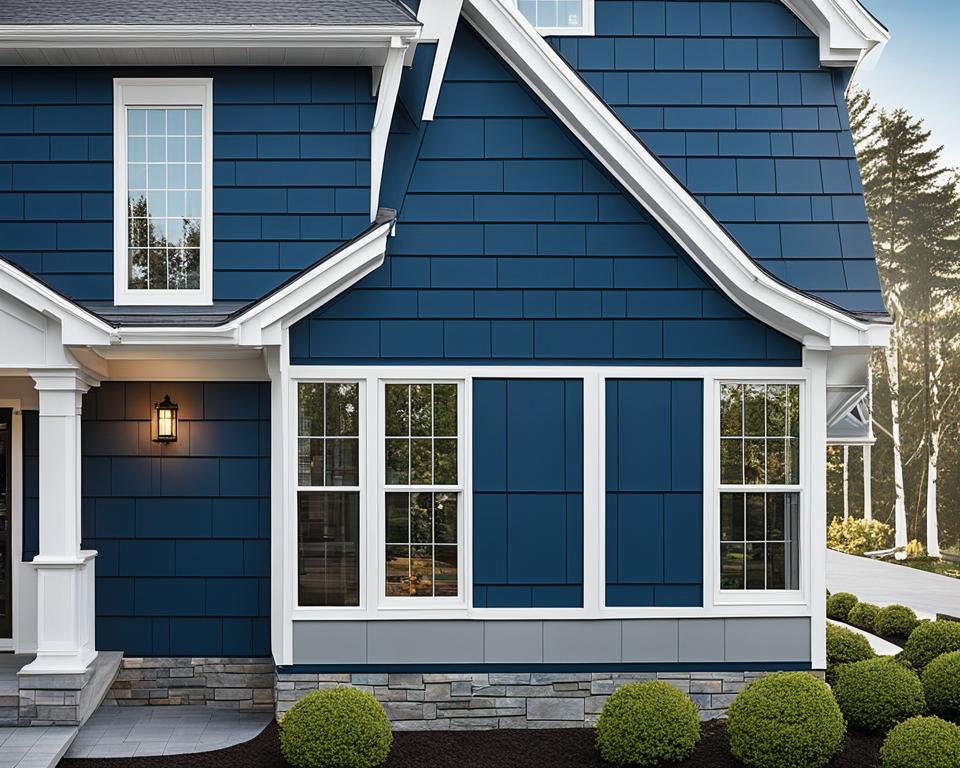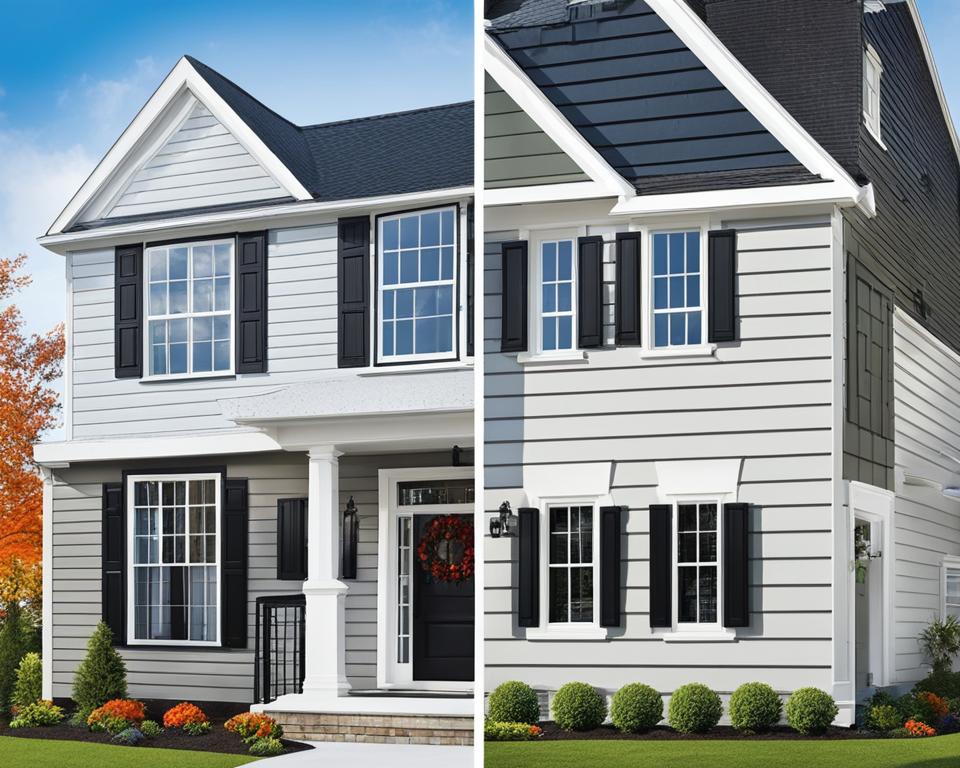When it comes to choosing the right siding for your home, dutch lap siding and traditional vinyl siding are two popular options to consider. While they may seem similar at first glance, there are important distinctions between the two that can influence your decision. In this article, we will compare the pros and cons of dutch lap and traditional vinyl siding to help you make an informed choice for your home.
Key Takeaways:
- Dutch lap siding and traditional vinyl siding are both popular choices for homeowners.
- Dutch lap siding offers a unique aesthetic with its notched overlap and shadow lines.
- Traditional vinyl siding provides a classic and versatile look.
- Both options are low-maintenance and resistant to rot and pests.
- The cost and installation process may differ between the two options.
Now, let’s dive deeper into what makes dutch lap and traditional vinyl siding unique and explore the advantages and disadvantages of each.
What is Dutch Lap Siding?
Dutch lap siding is a unique variant of clapboard siding that offers distinct aesthetic features and installation characteristics. It is characterized by a concave edge and a notched overlap, creating visually appealing shadow lines and adding texture to the home’s exterior.
This siding style is available in various materials, including wood and vinyl, providing homeowners with options to suit their preferences and budget. Dutch lap siding is known for its versatile nature, complementing a wide range of architectural styles and designs.
One of the key benefits of Dutch lap siding is its attractive aesthetics. The concave edge and notched overlap create an eye-catching profile that adds depth and dimension to the home’s facade. The shadow lines created by the overlapping planks give the siding a dynamic and visually interesting appearance.
Furthermore, Dutch lap siding offers durability and low maintenance. It is resistant to rot, pests, and weather damage, ensuring longevity and minimal upkeep requirements. This makes it an excellent choice for homeowners looking for a low-maintenance siding option that can withstand the elements.
The installation process for Dutch lap siding requires attention to detail and precision. The notched overlap must be aligned correctly to create a seamless and visually pleasing look. It is recommended to hire professional installers who have experience working with Dutch lap siding to ensure proper installation and optimal results.
“Dutch lap siding’s unique profile adds dimension and visual interest to any home’s exterior, making it a popular choice among homeowners.”
When it comes to materials, wood and vinyl are the most commonly used options for Dutch lap siding. Wood offers a natural and authentic look, while vinyl provides affordability and low maintenance. Homeowners can choose the material that best suits their priorities and preferences.
Dutch Lap Siding Features:
- Concave edge and notched overlap for attractive shadow lines
- Available in wood and vinyl materials
- Versatile and complements various architectural styles
- Durable and resistant to rot, pests, and weather damage
- Requires professional installation for optimal results

| Dutch Lap Siding | Features | Materials |
|---|---|---|
| Aesthetics | Concave edge and notched overlap for attractive shadow lines | Wood, vinyl |
| Compatibility | Versatile and complements various architectural styles | Wood, vinyl |
| Durability | Resistant to rot, pests, and weather damage | Wood, vinyl |
| Installation | Requires professional installation for optimal results | Wood, vinyl |
What is Traditional Vinyl Siding?
Traditional vinyl siding is a popular choice for homeowners looking for a durable and low-maintenance option to enhance the aesthetic appeal of their homes. While often mistaken for clapboard siding, traditional vinyl siding has some distinct features that set it apart.
Unlike clapboard siding, which consists of individual planks with overlapping edges, traditional vinyl siding is made up of straight-edged planks that overlap to create the illusion of individual planks. This overlapping design gives traditional vinyl siding its classic and timeless look.
Traditional vinyl siding is commonly used in various architectural styles such as Colonial, ranch, and historic homes. It offers versatility in terms of color options, allowing homeowners to choose from a wide range of hues that best suit their preferences and complement their home’s exterior.
One of the key advantages of traditional vinyl siding is its durability. Made from high-quality materials, it is resistant to weather damage, including fading, warping, and cracking. This makes it a long-lasting choice that can withstand the test of time.
Furthermore, traditional vinyl siding is known for its low maintenance requirements. Unlike other siding options that may require regular painting or sealing, traditional vinyl siding only requires occasional cleaning to maintain its appearance.
When it comes to installation, traditional vinyl siding can be installed quickly and efficiently. Its straightforward installation process makes it a popular choice among homeowners and contractors alike.
Traditional Vinyl Siding Features:
- Durable and weather-resistant
- Low-maintenance
- Wide range of color options
- Easy and efficient installation

Overall, traditional vinyl siding combines aesthetic appeal, durability, and ease of installation, making it a practical choice for homeowners seeking a cost-effective and visually pleasing siding option.
Dutch Lap vs Traditional Vinyl Siding: A Comparison
When comparing dutch lap siding and traditional vinyl siding, it’s important to weigh the pros and cons of each option. Both types of siding have unique characteristics that may influence your decision.
Pros and Cons of Dutch Lap Siding
Dutch lap siding offers a distinctive aesthetic appeal with its notched overlap and shadow lines. The concave edge creates a visual texture that adds depth and charm to the home’s exterior. Some of the advantages and disadvantages of dutch lap siding include:
- Pros:
- Unique and attractive appearance
- Enhanced curb appeal
- Compatible with a variety of architectural styles
- Cons:
- May be slightly more expensive than traditional vinyl siding
- Requires precise installation for optimal results
Pros and Cons of Traditional Vinyl Siding
Traditional vinyl siding is a popular choice known for its durability and low maintenance requirements. Here are some of the advantages and disadvantages of traditional vinyl siding:
- Pros:
- Classic and versatile appearance
- Available in a wide range of colors
- Durable and resistant to rot and pests
- Cons:
- Does not offer the same depth and texture as dutch lap siding
- May not suit all architectural styles
Cost and Durability Comparison
When it comes to cost, dutch lap siding and traditional vinyl siding are generally comparable. However, dutch lap siding may be slightly more expensive due to its unique design. In terms of durability, both options are low-maintenance and resistant to rot and pests. It’s important to note that proper installation and regular maintenance are crucial to ensure the longevity of either siding option.
Installation Differences
The installation process for dutch lap siding and traditional vinyl siding may differ due to their respective designs. Dutch lap siding requires more precision and attention to detail during installation to achieve the desired aesthetic. On the other hand, traditional vinyl siding is typically straightforward to install with its straight-edged planks.
| Dutch Lap Siding | Traditional Vinyl Siding | |
|---|---|---|
| Appearance | Unique with notched overlap and shadow lines | Classic and versatile |
| Cost | Slightly more expensive | Comparable |
| Durability | Low-maintenance and rot/pest resistant | Low-maintenance and rot/pest resistant |
| Installation | Requires precision and attention to detail | Straightforward installation |
It’s important to consider your personal preferences, budget, and home style when choosing between dutch lap siding and traditional vinyl siding. Consulting with a professional siding contractor can also provide valuable insights to help you make the best decision for your home.
Conclusion
In conclusion, when it comes to choosing between dutch lap siding and traditional vinyl siding, there are several factors to consider. Your personal preference, the style of your home, and your budget will play a significant role in making the right decision.
Dutch lap siding offers a unique and visually appealing look with its notched overlap and shadow lines. It adds character and texture to your home’s exterior, particularly suiting Victorian and Greek revival architectural styles. On the other hand, traditional vinyl siding provides a timeless and versatile option with straight-edged planks that create the illusion of individual planks. It is commonly used in Colonial, ranch, and historic homes.
Consider the aesthetics, cost, durability, and installation requirements of each option. Both dutch lap siding and traditional vinyl siding have their advantages and disadvantages. While dutch lap siding may be slightly more expensive, both types of siding are low-maintenance, resistant to rot and pests, and offer long-lasting durability. Installation processes may vary, with dutch lap siding requiring a more precise and detailed approach.
For the best outcome, it is recommended to consult with a professional siding contractor who can guide you based on your specific needs. They will ensure that you select the siding option that aligns with your preferences, enhances the style of your home, and fits within your budget constraints.
FAQ
What are the benefits of dutch lap siding?
Dutch lap siding offers a unique aesthetic with its notched overlap and shadow lines. It adds visual texture to the home’s exterior and pairs well with various architectural styles.
What are the advantages of traditional vinyl siding?
Traditional vinyl siding provides a classic and versatile look. It is durable, low-maintenance, and available in a wide range of colors.
How do I choose between dutch lap and traditional vinyl siding?
The choice depends on personal preference, the style of your home, and your budget. Consider the unique aesthetics, cost, durability, and installation requirements of each option.
What are the differences between dutch lap and traditional vinyl siding?
Dutch lap siding has a concave edge and a notched overlap, creating shadow lines and visual texture. Traditional vinyl siding consists of straight-edged planks that overlap to create the appearance of individual planks.
Which is better – dutch lap or traditional vinyl siding?
The better option depends on your specific needs and preferences. Dutch lap siding offers a unique and visually appealing look, while traditional vinyl siding provides a timeless and versatile option.
How much does dutch lap siding cost compared to traditional vinyl siding?
The cost of dutch lap siding and traditional vinyl siding is comparable, although dutch lap siding may be slightly more expensive.
How durable are dutch lap siding and traditional vinyl siding?
Both types of siding are low-maintenance and resistant to rot and pests. They offer long-lasting durability for your home’s exterior.
Are there any installation differences between dutch lap and traditional vinyl siding?
The installation process may vary, with dutch lap siding requiring more precision and attention to detail due to its unique profile. It is recommended to consult with a professional siding contractor for proper installation.
